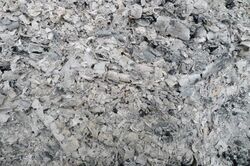Ash
Topic: Physics
 From HandWiki - Reading time: 2 min
From HandWiki - Reading time: 2 min
Ash or ashes are the solid remnants of fires.[1] Specifically, ash refers to all non-aqueous, non-gaseous residues that remain after something burns. In analytical chemistry, to analyse the mineral and metal content of chemical samples, ash is the non-gaseous, non-liquid residue after complete combustion.
Ashes as the end product of incomplete combustion are mostly mineral, but usually still contain an amount of combustible organic or other oxidizable residues. The best-known type of ash is wood ash, as a product of wood combustion in campfires, fireplaces, etc. The darker the wood ashes, the higher the content of remaining charcoal from incomplete combustion. The ashes are of different types. Some ashes contain natural compounds that make soil fertile. Others have chemical compounds that can be toxic but may break up in soil from chemical changes and microorganism activity.
Like soap, ash is also a disinfecting agent (alkaline).[2] The World Health Organization recommends ash or sand as alternative for handwashing when soap is not available.[3]
Natural occurrence
Ash occurs naturally from any fire that burns vegetation, and may disperse in the soil to fertilise it, or clump under it for long enough to carbonise into coal.
Specific types
- Wood ash
- Products of coal combustion
- Cigarette or cigar ash
- Incinerator bottom ash, a form of ash produced in incinerators
- Volcanic ash, ash that consists of fragmented glass, rock, and minerals that appears during an eruption.
Cremation ashes
Cremation ashes, also called cremated remains or "cremains," are the bodily remains left from cremation.[4] They often take the form of a grey powder resembling coarse sand. While often referred to as ashes, the remains primarily consist of powdered bone fragments due to the cremation process, which eliminates the body's organic materials.[5][6] People often store these ashes in containers like urns, although they are also sometimes buried or scattered in specific locations.[7]
See also
- Ash (analytical chemistry)
- Cinereous, consisting of ashes, ash-colored or ash-like
- Potash, a term for many useful potassium salts that traditionally derived from plant ashes, but today are typically mined from underground deposits
- coal, consisting of carbon as ash, and ash can be converted into coal
- carbon, basic component of ashes
- charcoal, carbon residue after heating wood mainly used as traditional fuel
References
- ↑ "the definition of ash" (in en). http://www.dictionary.com/browse/ash.
- ↑ Howard et al. 2002: Healthy Villages A guide for communities and community health workers. CHAPTER 8 Personal, domestic and community hygiene. WHO. Accessed Oct. 2014. http://www.who.int/water_sanitation_health/hygiene/settings/hvchap8.pdf
- ↑ WHO 2014: Water Sanitation Health. How can personal hygiene be maintained in difficult circumstances? Accessed Oct. 2014 [1]
- ↑ "What Are Cremains? (& What to Do with Them) » Urns | Online". https://www.usurnsonline.com/cremation/cremains/.
- ↑ "All About Cremation Ashes | What Are Human Ashes Made of | Scattering Ashes". https://www.cremationsolutions.com/information/scattering-ashes/all-about-cremation-ashes.
- ↑ "Education | Cremation ashes". https://www.lonite.ca/education/cremation-ashes.html.
- ↑ "What To Do With Cremated Remains". https://www.cremation.com/cremation-memorialization/10-things-to-do-with-cremated-remains/.
 |
 KSF
KSF
